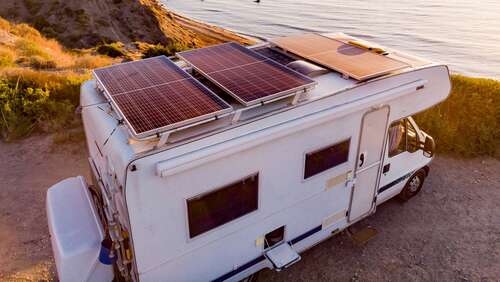
RV solar panels work pretty much the same way the solar panels installed on residential properties do. The only difference is that they deliver a slightly more modest output. Regardless of the type of system you install, the photovoltaic cells in solar panels convert the available sunlight into electricity, which you can then use to power the appliances and devices in your RVs. For this entire process to work, numerous components are required, including solar panels, a battery, an inverter, and a solar charge controller.
The solar panels are what contain PV cells — you can either install the panels on the roof of your RV by drilling holes or purchase a portable kit. Keep in mind that you may need to purchase several solar panels based on your energy needs and the wattage per panel. If you have a large RV with a wide roof, you could install residential panels instead of traditional RV panels; this might allow you to get the power supply you need without purchasing too many panels.
Given that your solar panels can only convert sunlight into electricity when there is sunlight available, you might want to purchase a battery to store electricity for nighttime usage. You will also need to purchase a charge controller, which regulates the flow and speed of electricity from the solar panels to the battery, ensuring that the battery doesn’t overcharge or suffer any other kind of damage. If you want to use both AC and DC power, you’ll need to purchase a solar inverter that converts the energy to alternating current (AC) from direct current (DC). You’ll find that this is essential if you plan on powering household appliances, like kitchen appliances and laptops, that typically run on AC power.

